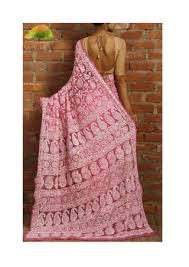The History and Origins of Chikankari Fabrics
Categories: Embroioderies

The History and Origins of Chikankari Fabrics
Chikankari is a fragile embroidery style that began in the Mughal period in India. Having begun in Lucknow, a city in northern India, in the eighteenth century is accepted. "Chikankari" comes from the Persian word "chikan," and that signifies "embroidery." Chikankari is a customary type of weaving that is as yet well known in India today.
The starting points of chikankari are not satisfactory, however it is accepted to have been acquainted with India by the Persians in the seventeenth hundred years. The Mughal rulers were extraordinary supporters of artistic expression, and they energized the advancement of chikankari embroidery. It became well known among the honorability and the rich, who charged talented craftsmans to make complex plans on their attire.
Chikankari embroidery is normally finished on lightweight fabric like cotton, muslin, and silk. The embroidery is finished utilizing white string on a white or pastel-hued texture, giving it an unobtrusive and rich appearance. The plans are frequently botanical or mathematical, and the embroidery is finished utilizing various lines, including the backstitch, chain fasten, and silk join.
Chikankari embroidery o made chikankari plans were profoundly regarded, and their work was exceptionally valued. Today, chikankari embroidery is as yet finished manually, however it is likewise done utilizing machines. Nonetheless, hand tailored chikankari is as yet viewed as the most important and profoundly valued.
Chikankari fabrics are as yet famous in India today, and they are frequently used to make conventional articles of clothing like kurtas, sarees, and dupattas. They are likewise used to make present day plans, and chikankari embroidery is frequently integrated into Western apparel too. Chikankari fabrics are known for their magnificence, polish, and immortal allure, and they keep on being a dearest part of Indian material legacy.
How to Care for Your Chikankari Fabrics: Tips and Tricks
Chikankari fabrics are sensitive and require exceptional consideration to keep up with their magnificence and life span. Here are a few hints and deceives on the most proficient method to really focus on your chikankari fabric:
Hand Wash: Chikankari fabrics ought to be hand-washed in chilly water with a delicate cleanser. Try not to involve blanch or brutal cleansers as they can harm the fabrics.
Soak before washing: Absorb the fabric water for 10-15 minutes prior to washing to slacken any soil or stains.
Avoid wringing or twisting: In the wake of washing, don't wring or wind the fabric. All things considered, delicately press out the overabundance water and lay it level to dry.
Stay away from direct daylight: Direct daylight can make the fabric blur, so consistently dry chikankari fabric in a concealed region.
Iron carefully: Utilize a low intensity setting and a squeezing material to press chikankari fabric. Try not to utilize a steam iron, as the dampness can harm the sensitive embroidery.
Store appropriately: While putting away chikankari fabric, overlap them cautiously and store them in a cool, dry spot. Try not to hang them, as this can cause extending and contortion of the embroidery.
Spot clean: In the event that you really want to eliminate a mess from chikankari fabric, utilize a gentle cleanser and delicately touch the impacted region with a perfect material. Try not to rub the fabric, as this can harm the embroidery.
By following these tips and deceives, you can keep your chikankari fabric looking wonderful for quite a long time into the future.